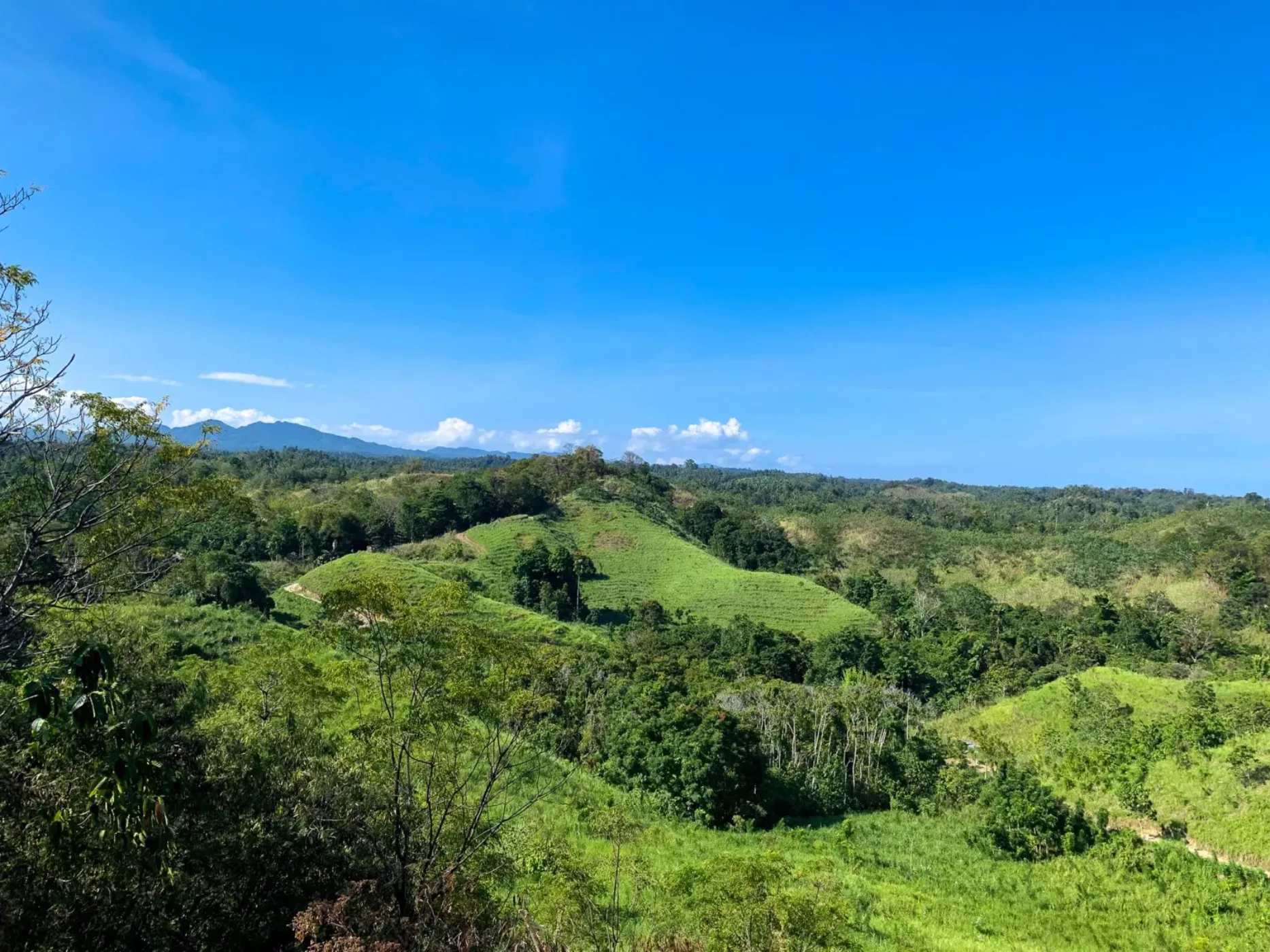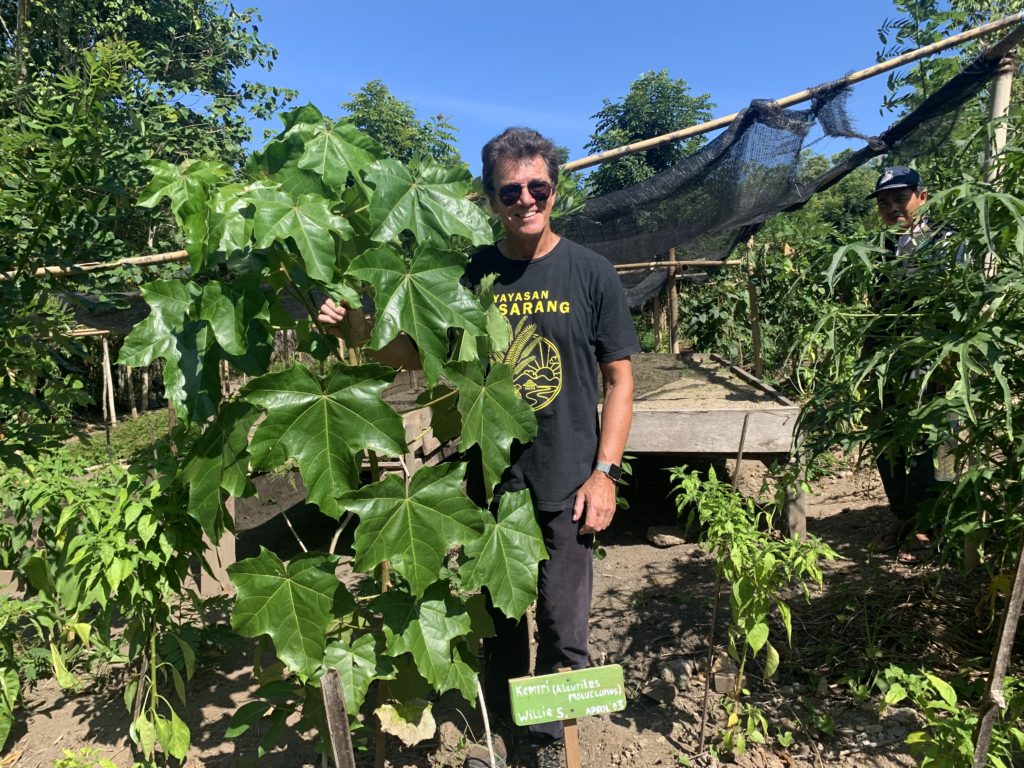From grassland to forest in just three years on Sulawesi
06 December 2023

06 December 2023
Planting a new tropical forest in just three years. On North Sulawesi, we saw with our own eyes that it was possible. Trees for All is supporting the Masarang Foundation in realising an innovative and challenging reforestation project. A total of 160,000 trees will be planted, in order to transform monotonous grassland into tropical rainforest. In September, our director and programme manager international projects paid a visit to the project. So what’s it looking like now?
On the Indonesian island of Sulawesi, you find all sorts of ecosystems, such as rainforests, mangrove forests and coral reefs. The rainforests are home to dozens of species of animal that are not found anywhere else in the world. They include the spectral tarsier and the crested macaque. The bad news is that around 80% of their habitat has disappeared due to deforestation, meaning that these animals are threatened with extinction.
In order to restore this unique ecosystem, we’re supporting the Masarang Foundation’s project in Temboan. The foundation was set up by Willie Smits, a Dutch conservationist and forestry expert who has been active in Indonesia for over 40 years.
Masarang – named after the volcano in the region – has bought up around 600 hectares of land in Temboan from the neighbouring villages and private landowners. These former forest areas were transformed decades ago into coconut plantations and agricultural fields. The annual slash and burn practices have depleted the soil, resulting in prolific growth of the tenacious alang-alang grass.
Alang-alang is a big problem in Indonesia and other Asian countries. Millions of hectares of land are covered in the tenacious grass. That means that the land has no ecological or economic value any more. For example, trees can’t put down roots in between the metres-high, choking grass, making natural forest recovery impossible without a helping hand.
And we’d like to lend that helping hand. Together with the Masarang Foundation, we’re transforming 50 hectares of alang-alang grass into tropical rainforest. We’re doing so by planting trees in an unusual way.
We’re very impressed by the initial results of the Masarang project. While walking through the area, we saw with our own eyes that a new forest can grow within three years. Even the trees we planted less than six months ago are growing fast, and the saplings are already sticking up above the alang-alang grass. That’s very promising indeed!
This rapid development into a forest is due to a successful planting method devised by Willie Smits. The planting takes place in two phases. By first planting fast-growing tree species, known as pioneer species, a shady environment is soon created. This means that the grass dies back.
The pioneer species are felled before the trees can spread their seed and they are used for sustainable purposes. For example, surfboards are made out of the light wood of the balsa tree. In the second phase, Masarang plants native species that can grow in the shade, which will grow to form a diverse tropical forest again.
Masarang’s method of planting trees testifies to great expertise. The quality of the seedlings is high and the planting is carried out with great care, mainly by women, who according to Willie are best at the job.
How does it work? A project worker carefully removes the young tree from the bag and places it in a planting hole. He/she adds compost and biochar, which is a sort of charcoal made from pruning waste. Heated to a very high temperature, the biochar boosts soil fertility and sequesters a lot of carbon. Afterwards, the ground is covered with mulch; a mixture of straw and other vegetation.
Our Trees for All planting area measures around 50 hectares. In the coming years, we’ll fill it with a total of 160,000 trees. We’ve facilitated the construction of a 15-metre-high observation tower, and we were able to climb it for a wonderful 360-degree view of our planting area. In a month’s time, high-tech cameras will be positioned that can monitor everything. Then we’ll be able to follow the growth of our forest from a distance, through an internet connection.
We also paid visits to the two neighbouring villages of Temboan and Rumbia, which gave us a good picture of the dynamics of the project and how it started. Initially, the local village chiefs thought Willie Smits was crazy. Why would a foreigner want to plant trees there? So the first reactions were of disbelief and mistrust. That is until they heard the well thought-out plans and felt the threat of other buyers from outside who wanted to use the land for their own profit. Then they put their trust in the Masarang Foundation – and rightly so!
The project not only ensures a more stable climate and the return of wildlife to the region, but also provides employment. This is very important to the neighbouring villages, where people have limited sources of income, apart from the proceeds from harvesting palm sugar, coconuts and spices, and from fishing.
This work is done mainly by men, which means there are no opportunities for the women to earn money as well. The neighbouring villages are poor and prospects are limited, so people resort to stealing turtle eggs, for example. In our project, the women do get extra opportunities to come and work in the nursery and in the field. Incidentally, the nursery was looking wonderful, with no fewer than 50 species that will be planted out!
There are many more plans to expand on employment opportunities. They include ecotourism and local projects, such as the larger-scale production of palm sugar, processing of coconut shells and processing of waste wood into biochar and other products. This long-term vision is important to the local community, because when the reforestation is complete in a few years’ time, it’s crucial that the neighbouring communities feel involved and can support themselves in the long term.
The local population is already pleased with the results and the plans for starting up ecotourism in the future. What improvements are they noticing already?

The visit showed us that the project has been extremely well thought-out. Everything is circular and connected. We can’t wait until the next planting season, when the rest of the trees will be planted. It will create a forest for the future, which will be beneficial to people, animals and nature itself.
We’ll also be investigating how we can use this planting method on a wider scale in reforesting alang-alang fields. And we’re seeing that the use of biochar, as long as it’s produced properly, can give a huge impulse to the growth of young trees. We’ll pass on this knowledge to other project partners wherever relevant.
We monitor all our projects with care. To do so, we are involved in a project for at least ten years. Much of the monitoring we do remotely. In addition, field visits are an important part of our working method to see how the trees are doing on site. These visits are highly appreciated by our project partners and the population involved. They literally give us a face and show that we do not only provide support from a distance. This is how we make a success of the project together.